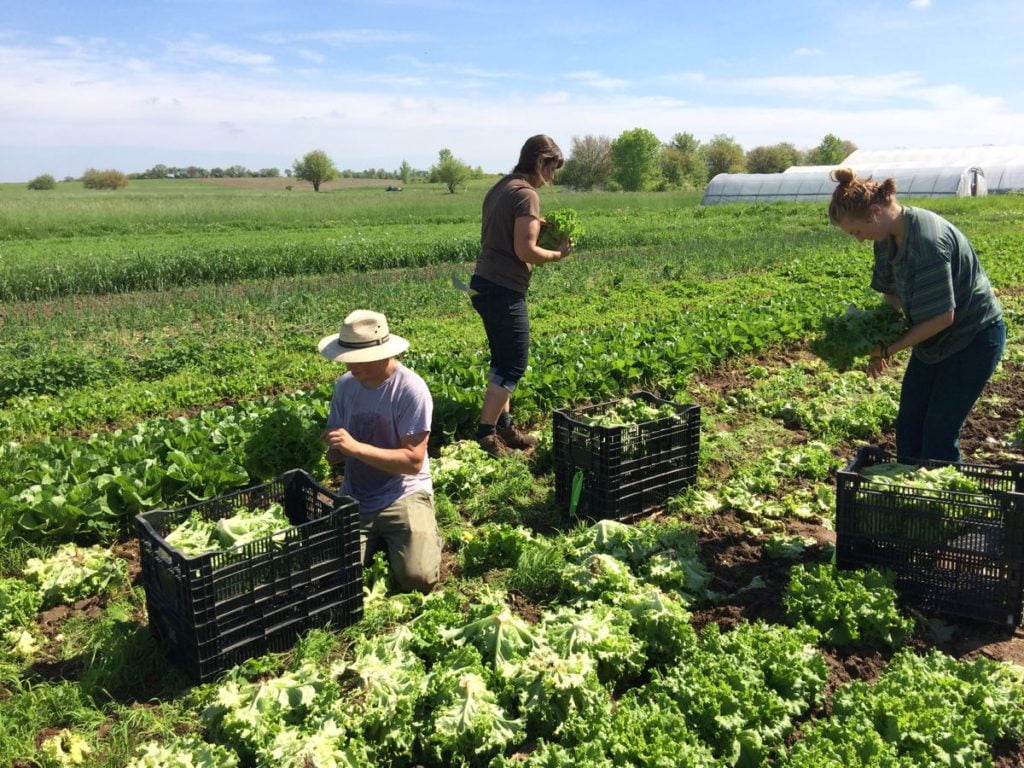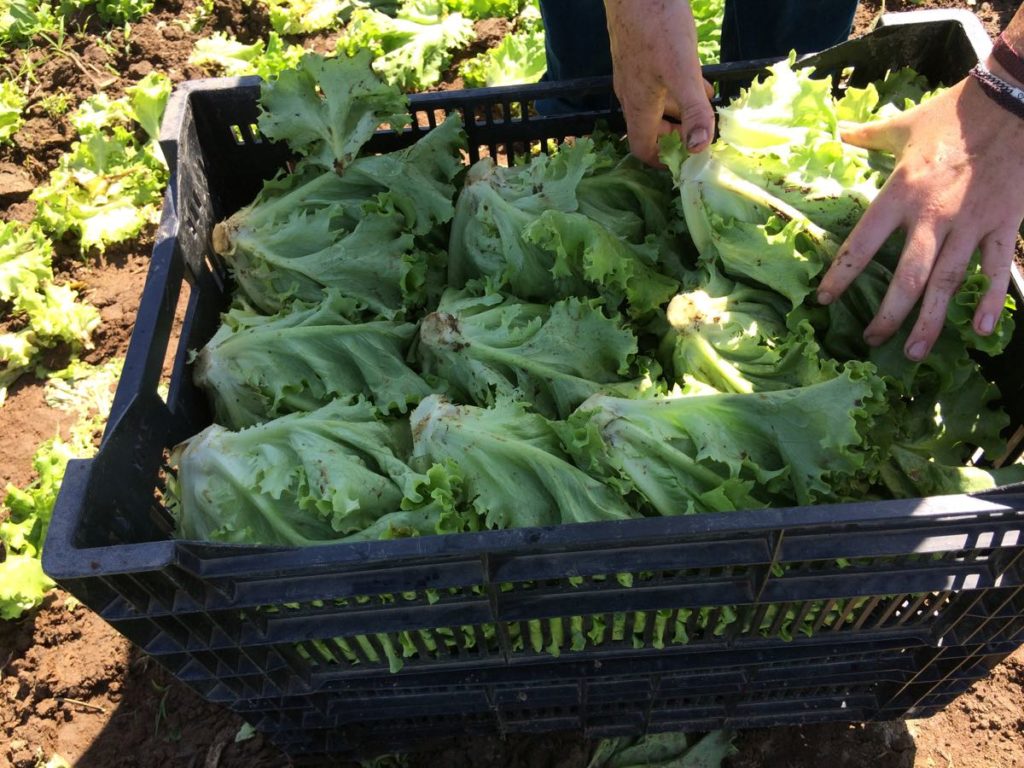Week #1, Let’s start!
- On: May 23, 2018
 0
0
Welcome to our CSA! Deliveries begin this week for weekly members and for green every-other-week (EOW) members. Go here to check the delivery schedule for other shares.
Things you need to know.
♦ We post this newsletter/blog each Wednesday night, with a list of veggies for the week, quantities, information about storage and preparation, news of the farm, recipes, and a forecast for the next week’s box. We alert you by email on Wednesday night once the newsletter is posted and ready to read.
♦ Want earlier notice of what will be in the box? Check the sidebar on our website homepage around 7 p.m. on Wednesday night. I’ll post the list under “Box Contents.” I also provide a tentative list for the following week in the Veggie List section of this newsletter. The next week’s list is rarely complete but the items listed are ones we feel confident about.
♦ EOW, sampler and weekly members, we assume you read all the newsletters, even on your “off” weeks. This newsletter (and our emails to you) are our means to communicate with you.
♦ The first few boxes of the season are often the lightest. EOW members, do not worry that you have signed up for the wrong share. Our deliveries get heavier and more abundant as the season progresses.
♦ We will sometimes write “OR” in the produce list, e.g. green leaf OR red bibb lettuce. You will receive one of these crops. All the boxes at each site are identical; we pack the same crops for all the members at each site. Please don’t open other members’ boxes.
♦ Wash your produce well this week to remove grit. It has rained a lot lately, driving grit into the asparagus and anything that forms a head (lettuce, bok choy, spinach). Our crew took extra care with washing but expect to wash everything. You should always wash your produce!
♦ On Thursday, we deliver CSA boxes to Evansville, Fitchburg, Madison, McFarland, Middleton and Oregon.
♦ On Friday, we deliver CSA boxes to Brookfield, Janesville, Mequon, Milwaukee, Waukesha and Wauwatosa.
A Tricky Spring Decision
In mid-April, we had to decide whether to transplant our precious greenhouse seedlings the day before a predicted snow storm. Seems crazy, right? Why not just wait? Well, we were already two weeks behind schedule, the plants were growing actively and our greenhouses were completely full. We had a CSA schedule to meet!
We decided to plant. As a rule, we use every opportunity to plant and transplant in late March and early April. If the ground gets soaked, it can take a long time to dry. We use row cover (a lightweight fabric) as an insurance policy, to moderate the cold and wind and to gather the sun’s warmth. This is a situation where experience is so helpful. We’ve been through this before and have yet to lose a crop by putting it out too early. Of course, we did wait for the 15 degree nights to pass before transplanting. That’s just common sense.
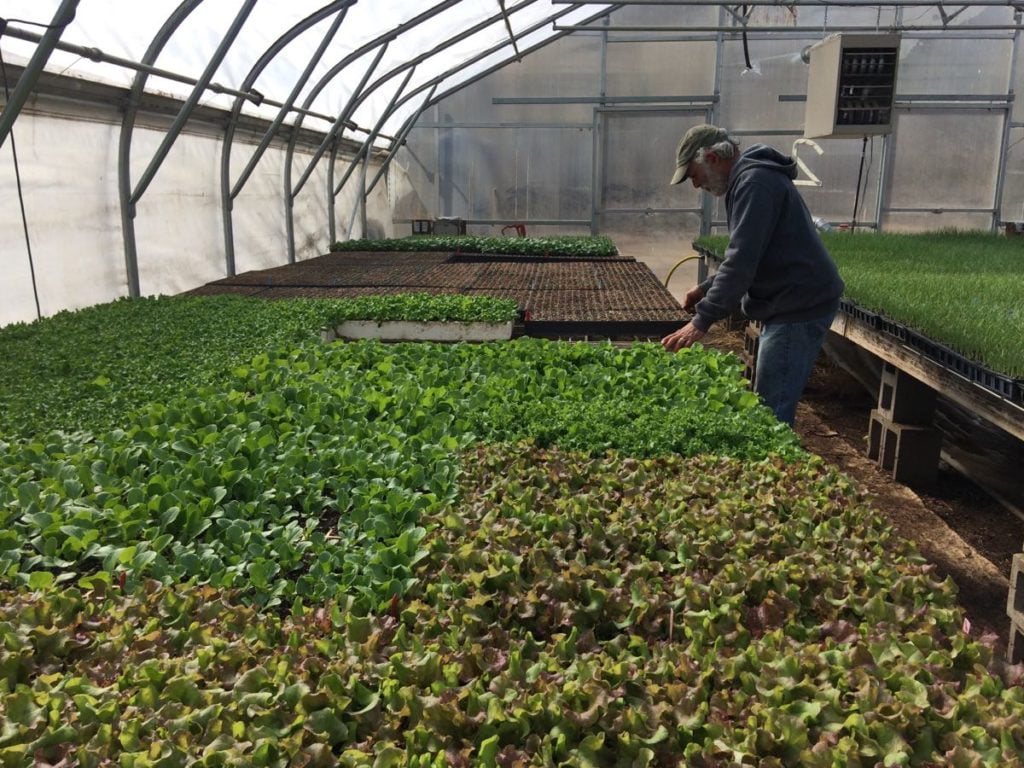
Our greenhouse seedlings are precious. It takes 6 to 8 weeks for them to grow to transplanting size, which means that we cannot replace them.
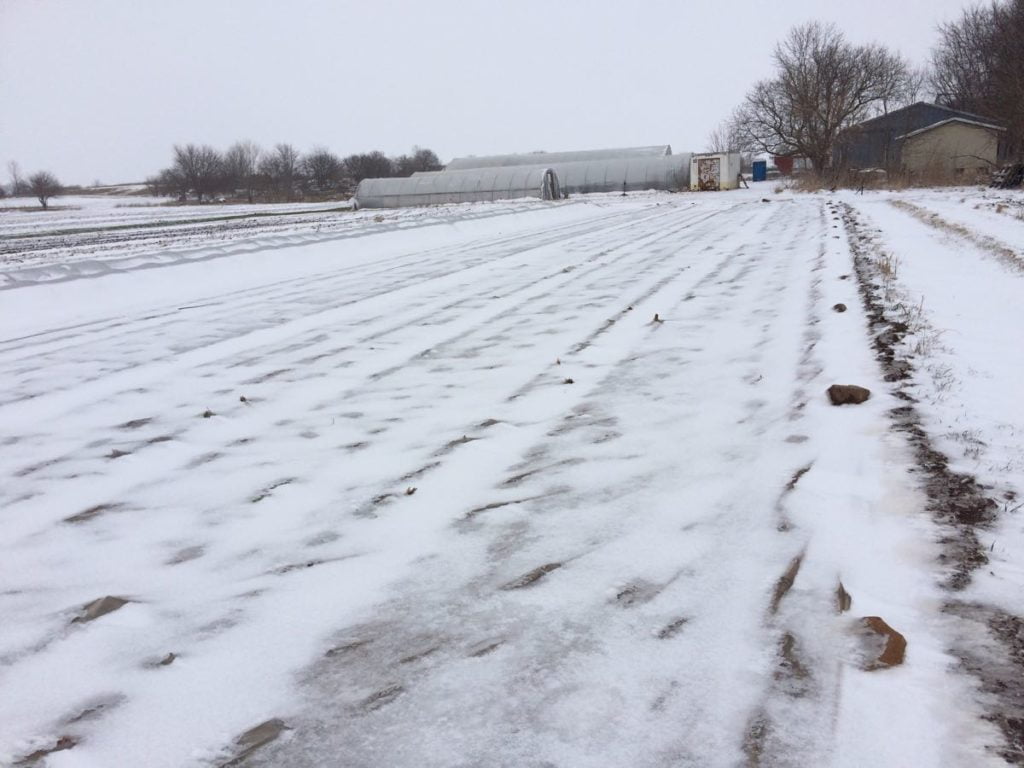
We transplanted on a beautiful sunny day, and covered the plants with floating row cover. It snowed the next day, weighing down the plants and freezing the row cover to the ground.
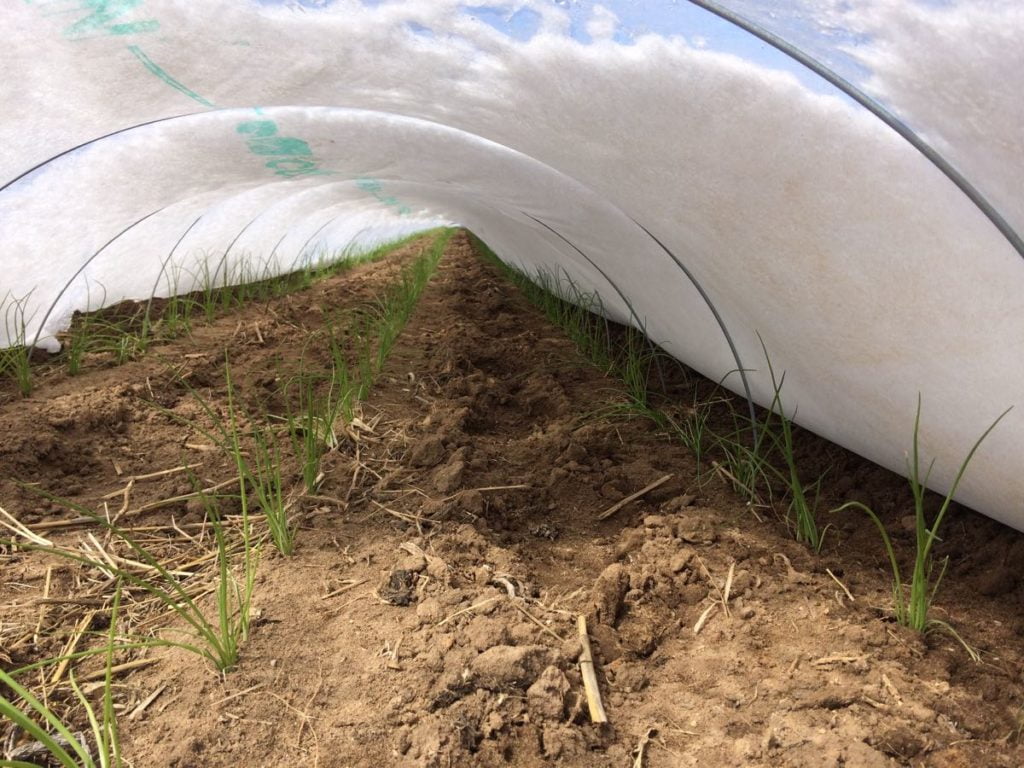
The plants did fine. The row cover makes a nice shelter and traps heat from the ground.
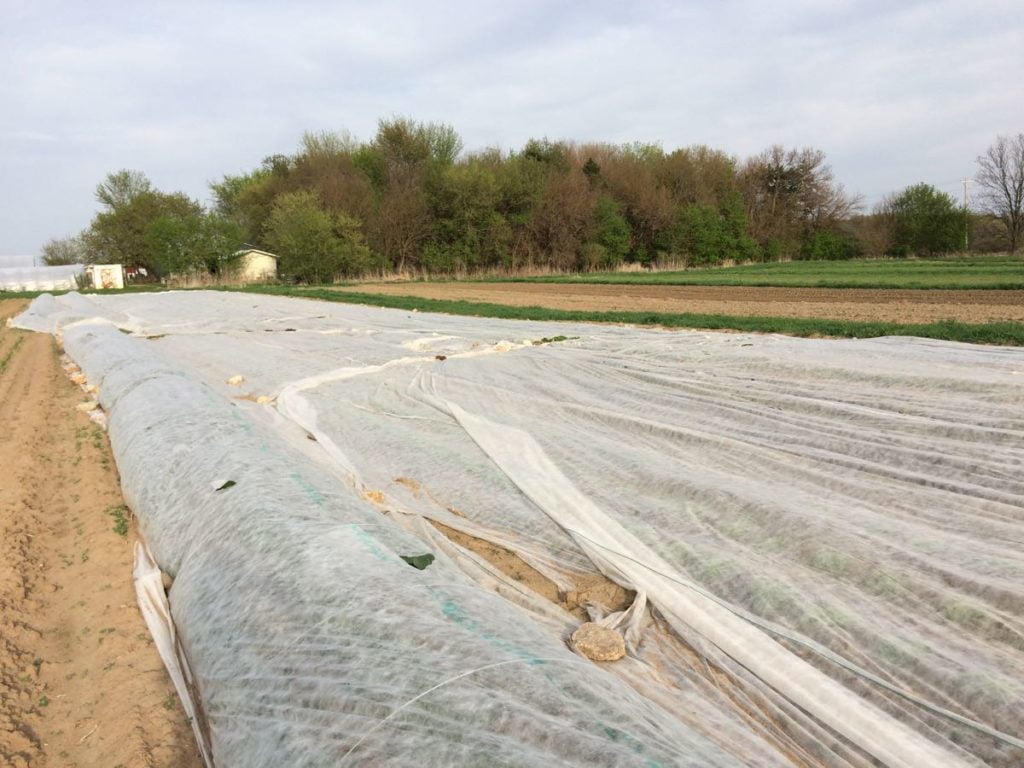
The row cover was seriously beaten up by the weather. We patched it together because we did not want to replace it with a new $300 piece. Your bok choy has some insect damage as a result; the flea beetles snuck in through the holes.
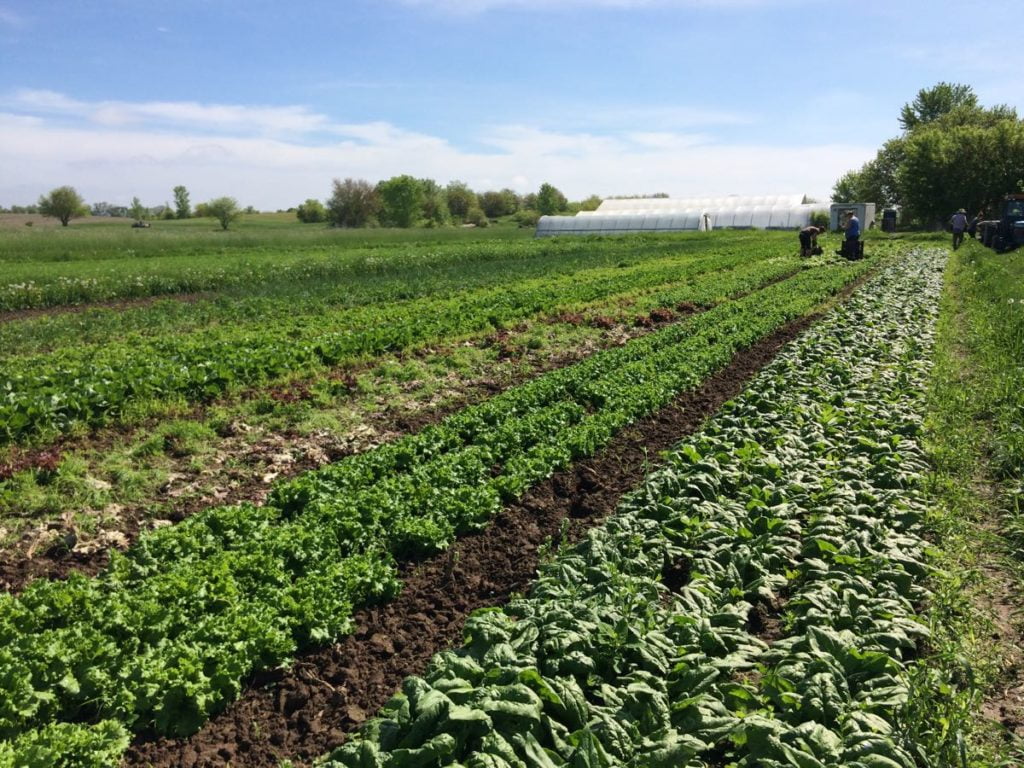
Otherwise, everything did very, very well.
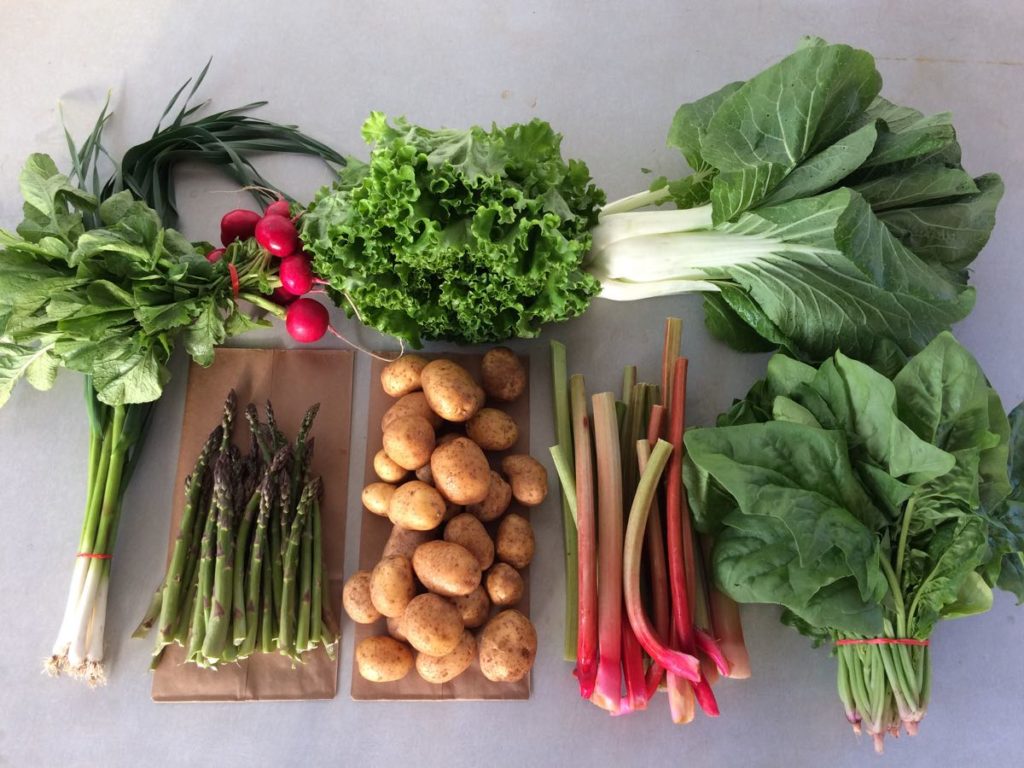
The happy resolution to the story.
Veggie List and Veggie Notes
May 24/25, 2018 (Th/Fri sites), week #1, green EOW
Asparagus, ~1 lb
Spinach, 1 big bunch
German Butterball potatoes, 3.5 lb
Green leaf lettuce
Salad radishes, 1 bunch
Green garlic, 1 bunch
Bok choy, 1 large
Rhubarb, 2 lb
Next week’s box will probably contain asparagus, spinach, button mushrooms, lettuce, green garlic, Abyssinian mustard, rhubarb and more.
Asparagus – Enjoy this spring treat! Your asparagus will be green or purple. The purple variety turns dark green when cooked. Its flavor is almost identical to normal green asparagus. Wash your asparagus thoroughly to remove hidden grit. Submerge in water with the tips pointing down, soak briefly, then swish vigorously and pull out of the water. The draining action helps pull the grit out of the asparagus tips. Repeat several times.
Storage: Asparagus is perishable, so eat it as soon as possible. Store it in the paper bag we packed it in, and wrap loosely in a plastic bag. The paper bag protects the asparagus tips from direct contact with the plastic bag. The plastic bag keeps the asparagus from wilting.
Preparation: We snap our asparagus at harvest, rather than cutting. Therefore, there is no need to snap the stalks to remove fibrous ends. For the same reason, it is not necessary to peel the asparagus stalks. It’s OK to trim the cut end a bit.
Cooking: If your asparagus stalks vary greatly in size, you will want to cook the thicker ones longer. Put an empty steamer pot over water, and bring the water to a boil. Add the asparagus. Cover and steam over medium heat until just tender. Use two forks or a spatula to turn the asparagus during cooking, rotating the bottom spears to the top. Drain and serve. Alternatively, you can lay spears flat in the bottom of a broad pan, with ½ inch of water. Also excellent broiled or grilled. Good dressed with vinaigrette, or with lime juice, salt and pepper.
German Butterball potatoes – Please refrigerate these potatoes. They are in great shape now but will sprout within days if stored at room temperature. They’ve been stored all winter and want to grow. Store in a paper bag to protect from light, even in the fridge. We grow everything we send in our CSA boxes except potatoes, some of the garlic, and mushrooms, all of which we buy from organic growers that we trust. We purchased these potatoes from Jesse Perkins at Vermont Valley Farm. German Butterballs are good all-around potatoes with outstanding flavor. This variety was the first place winner in Rodale’s Organic Gardening “Taste Off.” Best uses are roasted, boiled or fried. With the predicted weather this weekend, you might want to make potato salad! Jesse says the potatoes have a higher sugar content because of starch to sugar conversion during cold storage. The potatoes taste a bit sweet, and will blacken slightly when fried. It’s a harmless color change due to the sugar conversion.
Lettuce and spinach – Wash your greens to remove grit splashed into the heads by rain. Cut to the size you like, submerge in water, swish gently, then pull from the water and drain in a colander. Some weeks, you will need to repeat in fresh water.
Storage hint – To extend the storage life of your tender greens, wash them, dry in a salad spinner, then store in a dry container or bag. Lettuce and spinach last much longer when handled this way.
Bok choy (large rosette with thick white stems and green leaves) – This Asian green is good for stir-frying or sautéing or in soup. You can think of the stems and leaves as two separate vegetables. The stems require longer cooking. The leaves will cook almost as quickly as spinach. Bok choy stores well, so feel free to pull off leaves as you need them, or use the whole head at once. Refrigerate in a plastic bag.
Green garlic (looks like scallions, tastes like garlic) – Last fall, we planted garlic cloves that grew into the stalks we harvested this week. If left to grow until mid-summer, the slim white bulb on this week’s garlic will divide and form the usual cluster of cloves in a garlic bulb. This year’s green garlic is robust.
Preparation: Green garlic is more pungent than scallions, so slice thinly and use sparingly when raw. It mellows when cooked. Chop and add to any cooked dish that would benefit from garlic. Use the white bulbs and pale green stems. Avoid the dark green stems and leaves, as these are fibrous.
Rhubarb – Refrigerate in a plastic bag. FYI, 2 lb of rhubarb yields 6 – 6.5 cups when chopped.
Stewed rhubarb: This is the simplest way to prepare rhubarb. Chop rhubarb into one inch chunks. Stir over medium heat with a small amount of water in the bottom of the pan. The rhubarb will release moisture as it cooks. Stew until it softens and falls apart. Sweeten to taste with honey or sugar. Eat warm on its own, over vanilla ice cream, on pancakes, etc.
Recipes from chef Pat Mulvey at Local Thyme
Comforting Classics
Spinach Salad with Pan Seared Asparagus, Steamed Potatoes, Chickpeas and Oven Poached Egg
Pureed Potato and Asparagus Soup with Spinach
White Bean Stew with Potato and Bok Choy
Rhubarb Compote with Fresh Ricotta
Outside the Box Recipes
Grilled Pizza with Wilted Spinach and Shaved Asparagus
Saag Paneer
Rhubarb Glazed Bok Choy and Radish
Spatchcocked Chicken and Potatoes with Rhubarb Butter
Quick and Easy Recipe
Classic Warm Spinach Salad
Recipes from Lauren
BEEF & GREENS STIR FRY WITH RHUBARB SAUCE
Not many people realize that rhubarb is as amazing in savory dishes as it is in desserts. Just like citrus, rhubarb lends a complex acidity and sweetness to dishes. I love to use rhubarb in Asian style recipes with powerful flavors that can balance it (like toasted sesame oil and soy sauce). Whip up this dish for a quick weeknight meal and remember why you waited so long for fresh produce. Lauren.
Serves 4.
Takes 45 minutes.
1 large head Bok Choy
3 tablespoons toasted sesame oil, divided
2 tablespoons water, plus more as needed
1/2 pound spinach
2 cups rhubarb, diced
3 green garlic, minced
3 tablespoons soy sauce
2 tablespoons apple cider vinegar
2 tablespoons white sugar
1 tablespoon honey
1 teaspoon garlic powder
1/4 teaspoon red pepper flakes
1 pound raw flank steak, cut into strips
2 cups cooked rice
Toasted sesame seeds, optional
- If you don’t have cooked rice in the fridge, begin your rice according to package directions.
- Remove individual leaves from the bok choy and thoroughly wash. Thinly slice the stalks (like you would celery). Roughly chop the leaves and keep in a separate pile from the stalks.
- In a large wide saute pan, heat 1 tablespoon toasted sesame oil with 2 tablespoons water over medium heat. Add bok choy greens and spinach and toss with oil and water to coat. Cover pan and steam for 5 minutes until just wilted. Remove greens from pan with tongs and set aside. Leave juices in pan.
- Add 1 tablespoon toasted sesame oil, rhubarb, green garlic, soy sauce, white sugar, honey, garlic powder and red pepper flakes to the same pan you cooked greens in. Simmer gently (and reduce mixture) over medium heat for 10-15 minutes, adding a tablespoon or two of water if it gets too thick. Remove sauce to a small bowl and again, don’t wipe out your pan.
- Add last tablespoon of toasted sesame oil to the pan along with bok choy stalks and steak. Cook over medium high heat 5-7 minutes until meat is cooked through. Add sauce and greens back to pan. Stir to combine and cook for about a minute, just to warm. Serve over rice and garnish with sesame seeds, if using.
.
SPRING HASH
Ingredients adapted from Smitten Kitchen recipe
I have no shortage of amazing asparagus recipes in my repertoire but for some reason or another, I come back to this one every year. I love the combination of smoky bacon and fresh tender asparagus, but I also love the versatility and heartiness of this dish created by Smitten Kitchen. This time around I added green garlic and radishes. It’s a perfect place to hide radishes if you aren’t a huge fan. Cooked radishes don’t taste all that different from a potato and you’ll relish the slight spice and bite they bring. Enjoy! Lauren.
Serves 4 depending what you serve with it.
Takes 45 minutes.
1/2 pound bacon, cut into 1/4-inch dice
2 cups potatoes, cut into 1/2-inch dice
1 cup radishes, cut into 1/2-inch dice
2 green garlic, thinly sliced
0.90 – 1 lb asparagus, ends trimmed and cut into 1-inch pieces
Salt and Pepper to taste
- Heat a 12-inch cast iron skillet or other large frying pan over medium heat. Fry the bacon, turning it frequently so it browns and crisps evenly. This should take about 10 minutes. Remove it with a slotted spoon and drain on paper towels. Leave the heat on and the bacon grease in the pan.
- Add the potatoes and radishes and donít move them for a couple minutes. Use this time to season them well with salt and pepper. Once theyíve gotten a little brown underneath, begin flipping and turning them, then letting them cook again for a few minutes. The idea is not to fight them off the frying pan, once theyíve gotten a little color, itís easier to flip them and youíve gotten closer to your goal of getting them evenly browned.
- When the potatoes and radishes are as crisped and brown as youíd like them ó this takes about 20 minutes ó add the green garlic and asparagus. Stir to combine and then add a lid. (It doesnít have to fit perfectly). Cook for an additional 5-10 minutes (thin spears of asparagus will take closer to 5 minutes, thick spears will take a bit longer) until asparagus is softened. Remove the lid, return the bacon to the pan for another minute, to reheat. Taste for seasoning and adjust if needed.
- Serve immediately with a fried egg on top and maybe a small salad of lettuce and thinly sliced radishes on the side.
.

